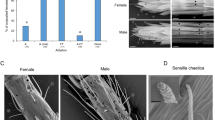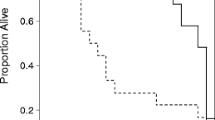Abstract
Oviposition deterrence is common in many insects as an evolutionary mechanism to reduce subsequent larval competition. We investigated a suspected case of oviposition deterrence by the paropsine chrysomelid, Chrysophtharta bimaculata. In paired choice tests, gravid females were found to prefer ovipositing on host leaves without conspecific eggs, confirming the presence of an apparent oviposition deterrence mechanism. Washing egg batches in water, hexane, or ethanol did not change this preference, suggesting that a soluble marking pheromone was not involved. Furthermore, it is unlikely that a plant-derived oviposition deterring substance is produced as beetles showed no significant oviposition preference between leaves which had been oviposited upon, but then had the eggs removed, and those that had never been oviposited upon. In trials using artificial leaves and mimic egg batches, “leaves” with “egg batches” placed near the tip of the leaf (the preferred site of oviposition in this species) were significantly less likely to be laid upon than artificial leaves where mimic eggs were placed away from the tip. In combination, the results strongly infer that oviposition deterrence in C. bimaculata is due to the mechanical blocking of the oviposition site by the first laid egg-batch, rather than a specific oviposition deterring cue. The apparent oviposition deterrence in this insect may well be an outcome or evolutionary effect of oviposition-site selection, rather than a clear adaptive mechanism to decrease larval competition.
Similar content being viewed by others
References
Anbutsu, H., and Togashi, K. (2002). Oviposition deterrence associated with larval frass of the Japanese pine sawyer, Monochamus alternatus (Coleoptera: Cerambycidae). J. Insect Physiol. 48: 459–465.
Anderson, P. (2002). Oviposition pheromones in herbivorous and carnivorous insects. In Hilker, M., and Meiners, T. (eds.), Chemoecology of Insect Eggs and Egg Deposition, Blackwell Verlag, Berlin, pp. 205–233.
Boller, E. F., Hippe, C., Prokopy, R. J., Enkerlin, W., Katsoyannos, B. I., Morgante, J. S., Quilici, S., de Stilinovic, C., and Zapater, M. C. (1994). Response of wild and laboratory-reared Ceratitis capitata Wied. (Dipt., Tephritidae) flies from different geographic origins to a standard host marking pheromone solution. J. Appl. Entomol. 118: 84–91.
de Little, D. W. (1979). Taxonomic and ecological studies of the Tasmanian Eucalyptus-defoliating Paropsids (Coleoptera: Chrysomelidae), with particular reference to Chrysophtharta bimaculata (Olivier), PhD Thesis, University of Tasmania, Hobart, Australia.
Gauthier, N., and Monge, J. P. (1999). Could the egg itself be the source of the oviposition deterrent marker in the ectoparasitoid Dinarmus basalis? J. Insect Physiol. 45: 393–400.
Hilker, M. (1989). Intra- and interspecific effects of larval secretions in some chrysomelids (Coleoptera). Entomol. Exp. Appl. 53: 237–245.
Hilker, M., and Klein, B. (1989). Investigation of oviposition deterrent in larval frass of Spodoptera littoralis (Boisd.). J. Chem. Ecol. 15: 929–938.
Hilker, M., Rohfritsch, O., and Meiners, T. (2002). The plant’s response towards insect egg deposition. In Hilker, M., and Meiners, T. (eds.), Chemoecology of Insect Eggs and Egg Deposition, Blackwell Verlag, Berlin, pp. 205–233.
Hilker, M., and Weitzel, C. (1991). Oviposition deterrence by chemical signals of conspecific larvae in Diprion pini (Hymenoptera: Diprionidae) and Phyllodecta vulgatissima (Coleoptera: Chrysomelidae). Entomolt. Gen. 15: 293–301.
Howlett, B. G. (2000). Oviposition Site Selection in a Eucalypt Feeding Chrysomelid, PhD Thesis, University of Tasmania, Hobart, Australia.
Howlett, B. G., and Clarke, A. R. (2003). Role of foliar chemistry versus leaf-tip morphology in egg-batch placement by Chrysophtharta bimaculata (Olivier) (Coleoptera: Chrysomelidae). Aust. J. Entomol. 42: 144–148.
Howlett, B. G., Clarke, A. R., and Madden, J. L. (2001). The influence of leaf age on the oviposition preference of Chrysophtharta bimaculata (Olivier) and the establishment of neonates. Agric. For. Entomol. 3: 121–127.
Klijnstra, J. W. (1986). The effect of an oviposition deterring pheromone on egglaying in Pieris brassicae. Entomol. Exp. Appl. 41: 139–146.
Kozlowski, M. W., Lux, S., and Dimoch, J. (1983). Oviposition behaviour and pod marking in the cabbage seed weevil, Ceutorhynchus assimilis. Entomol. Exp. Appl. 34: 277–282.
Leonard, D. E., Wu, Z., and Ferro, D. N. (1987). Responses of the parasite Edovum puttleri to kairomone from eggs of Colorado potato beetle, Leptinotarsa decemlineata. J. Chem. Ecol. 13: 335–344.
Mumtaz, M. M., and Aliniazee, M. T. (1983). The oviposition-deterring pheromone in Rhagoletis indifferens Curran (Diptera, Tephritidae). 2. Chemical characterization and partial purification. Zeit. Ange. Entomol. 96: 93–99.
Nufio, C. R., and Papaj, D. R. (2001). Host marking behavior in phytophagous insects and parasitoids. Entomol. Exp. Appl. 99: 273–293.
Pelletier, Y. (1995). Recognition of conspecific eggs by female Colorado Potato Beetles (Coleoptera: Chrysomelidae). Environ. Entomol. 24: 875–878.
Raina, A. K. (1981). Deterrence of repeated oviposition in sorghum shootfly Atherigona soccata. J. Chem. Ecol. 7: 785–790.
Rothschild, M., and Schoonhoven, L. M. (1977). Assessment of egg load by Pieris brassicae (Lepidoptera: Pyralidae). Nature 266: 352–355.
Ruzicka, Z. (2001). Oviposition responses of aphidophagous coccinellids to tracks of ladybird (Coleoptera: Coccinellidae) and lacewing (Neuroptera: Chrysopidae) larvae. Eur. J. Entomol. 98: 183–188.
Sands, D. P. A., and Brancatini, V. A. (1991). A portable penetrometer for measuring leaf toughness in insect herbivory studies. Proc. Entomol. Soc. Wash. 93: 786–788.
Simmul, T. L., and de Little, D. W. (1999). Biology of the Paropsini (Chrysomelidae: Chrysomelinae). In Cox, M. L. (ed.), Advances in Chrysomelidae Biology 1, Backhuys, Leiden, The Netherlands, pp. 463–477.
Steinbauer, M. J., Clarke, A. R., and Madden, J. L. (1998). Oviposition preference of a Eucalyptus herbivore and the importance of leaf age on interspecific host choice. Ecol. Entomol. 23: 201–206.
Williams, G. C. (1966). Adaptation and Natural Selection. A Critique of Some Current Evolutionary Thought, Princeton University Press, Princeton, NJ.
Williams, K. S., and Gilbert, L. E. (1981). Insects as selective agents on plant vegetative morphology: Egg mimicry reduces egg laying by butterflies. Science 212: 467–469.
Author information
Authors and Affiliations
Corresponding author
Rights and permissions
About this article
Cite this article
Howlett, B.G., Clarke, A.R. Oviposition Deterrence Is Likely an Effect, Not a Mechanism, in the Leaf Beetle Chrysophtharta bimaculata (Olivier) (Coleoptera: Chrysomelidae). J Insect Behav 18, 609–618 (2005). https://doi.org/10.1007/s10905-005-7014-7
Revised:
Accepted:
Issue Date:
DOI: https://doi.org/10.1007/s10905-005-7014-7




